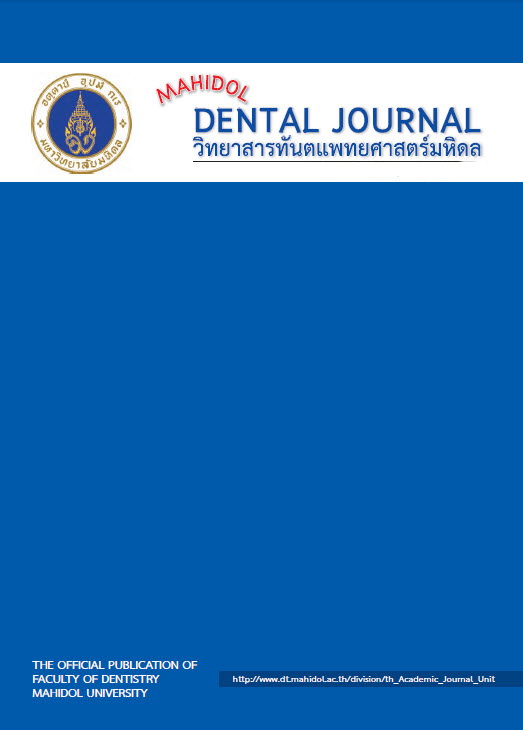Measurement of Abrasivity of Pumiceous tuff - contained Toothpaste on Dentin by Surface Profile Method
Main Article Content
Abstract
วัตถุประสงค์: เพื่อเปรียบเทียบความสึกเสียดสีที่เกิดจากยาสีฟันที่ผสมผงขัดพิวมิเชียสทัฟฟ์กับที่เกิดจากยาสีฟันมาตรฐานบนเนื้อฟันด้วยวิธีเซอร์เฟสโพรไฟล์ ตามข้อกำหนดของ British Standards Institution (BSI)
วัสดุอุปกรณืและวิธีการศึกษา: ทำชิ้นตัวอย่างจำนวน 16 ชิ้นจากฟันกรามน้อยถาวร 8 ซี่ โดยนำฟันมาแบ่งครึ่งในแนวใกล้กลาง- ไกลกลาง และฝังในบล็อกอีพอกซีเรซิ่น นำชิ้นตัวอย่างแต่ละชิ้นไปเข้าเครื่องแปรงฟันไฟฟ้าเพื่อทดสอบยาสีฟันตามลำดับคือ ยาสีฟันมาตรฐาน ยาสีฟันทดสอบและยาสีฟันมาตรฐานตามลำดับ วัดและบันทึกค่าความลึกรอยสึกที่เกิดขึ้นในแต่ละลำดับของการทดสอบและวิเคราะห์ข้อมูลตามที่BSI กำหนด
ผลการศึกษา: ค่าเฉลี่ยความลึกรอยสึกจากการแปรงที่ใช้ยาสีฟันผสมผงขัดพิวมิเชียสทัฟฟ์และยาสีฟันมาตรฐานคือ 19.5697 + 5.7643 และ 15.8599 + 3.4463 ไมโครเมตร ตามลำดับ ทั้งนี้ค่าเฉลี่ยความลึกรอยสึกจากการแปรงฟันที่ใช้ยาสีฟันผสมผงขัดพิวมิเชียสทัฟท์ มีค่าเป็น 1.2 เท่าของค่าเฉลี่ยความลึกรอยสึกจากการแปรงฟันที่ใช้ยาสีฟันมาตรฐานซึ่งไม่เกิน 2 เท่าตามที่ BSI กำหนด และค่าสัดส่วนของค่าความลึกรอยสึกที่ต่างไปจากค่ามาตรฐาน มีค่าเท่ากับ 2.82 ซึ่งเป็นค่าบวกและมากกว่าค่า t จากตาราง ค่า t จาก ตาราง Student’t distribution ที่ n=16ระดับนัยสำคัญ 0.05 มีค่าเท่ากับ 1.75Student’s t distribution เมื่อ n=16 ที่ระดับนัยสำคัญ 0.05 ซึ่งมีค่าเท่ากับ 1.75
บทสรุป: ยาสีฟันผสมผงขัดพิวมิเชียสทัฟฟ์ทำให้เกิดค่าความสึกเสียดสีบนเนื้อฟันอยู่ในเกณฑ์ที่ยอมรับได้ตามที่ BSI กำหนด
Article Details
References
2. Paster BJ, Boches SK, Galvin JL. Bacterial diversity in human plaque. J Bacteriol 2001;183:3770-83.
3. Lisgarten MA. The structure of dental plaque. Periodontol 2000 1994;5:52-65.
4. Daly CG , Highfield JE. Effect of localized experimental on early supragingival plaque accumulation. J Clin Periodontol 1996;23:160-4.
5. Hillam DG, Hull PS. The influence of experimental gingivitis on plaque formation. J Clin Periodontol 1997;4:56-61.
6. Quirynen M, Dekeyser C, van Steenberghe D. The influence of gingival inflammation: tooth type, and timing on the rate of plaque formation. J Periodontol 1991;62:219-22.
7. Ramberg P, Lindhe J, Dahlen G, Volpe AR. The influence of gingival inflammation on de novo plaque formation. J Clin Periodontol 1994;21:51-6.
8. Listgarten MA. The structure of dental plaque. Periodontol 2000 1994;5:52–65.
9. LÖe H, Theilade E, Jensen SB. Experimental gingivitis in man. J Periodontol 1965; 36: 177–87.
10. Jenkins B, Heasman P. Prevention and control of periodontal disease. In: Murray J, Nunn J, Steele J. Prevention of oral disease; 2003.p.126-44.
11. Dudding NJ, Dahl LO, Muhler JC. Patient reaching to brushing teeth with water, dentifrice or salt and soda. J Periodontol 1960;31:157-65 .
12. Stean H, Forward GC. Measurement of plaque growth following tooth brushing. Com Dent Oral Epi 1980;8:420-3.
13. สำนักงานมาตรฐานผลิตภัณฑ์อุตสาหกรรม กระทรวงอุตสาหกรรม. มาตรฐานผลิตภัณฑ์อุตสาหกรรมยาสีฟัน มอก.45-2549: พี เอ็น การพิมพ์ ; 2549.
14. Hunter ML, Addy M, Pickles MJ, Joiner A. The role of toothpastes and toothbrushes in the aetiology of tooth wear. Int Dent J 2002;52:399-405.
15. De Boer P, Duinkerke ASH, Arends J. Influence of tooth paste particle size and tooth brush stiffness on dentine abrasion in vitro. Caries Res 1985;19:232-9.
16. Shaw L. Tooth wear : aetiology ,prevention, clinical implication. In: Murray J, Nunn J, Steele J. Prevention of oral disease; 2003.p.115-22.
17. หินพัมมิซ (Pumice)และหินพัมมิเชียสทัฟฟ์ (Pumiceous tuff ) อ.สระโบสถ์ จ.ลพบุรี. หจก. คลองยาง;2551:1-10.
18. British standards institution . Specification for toothpastes : BS 5136;1981:1-12.
19. Davis WB. A comparison of dentine abrasion data generated by radiotracer and surface profilometer method. J Oral Rehab 1979;6:177-81.
20. Manly RS, Foster DM, Importance of factorial designs in testing abrasion by dentifrices. J Dent Res 1967;46:442-5.
21. Manly RS, Wirren J, Harte B, Ahern JA. Influence of method of testing and dentifrice abrasiveness. J Dent Res 1974;53:835-9.
22. Davis WB. The effect of irradiation and storage on the wear resistance of dentine. J Dent Res 1975;54:1078-81.
23. Fuentes V, Toledano M, Osorio R, Carvalho R. Microhardness of superficial and deep sound human dentin. J Biomed Mater Res 2003;66A: 850–3.
24. Svinnseth PN, Gjerdet NR , Lie T. Abrasivity of toothpastes: An in vitro study of toothpastes marketed in Norway. Acta Odont Scand 1987;45:195-202.
25. Redmalm G. Dentifice abrasivity: The use of laser light for determination of the abrasive properties of different silicas. An in vitro study. Swed Dent J 1986;10:243-50.
26. Moore C, Addy M. Wear of dentine in vitro by toothpaste abrasives and detergents alone and combined. J Clin Periodontol 2005;32(12):1242-6.
27. Johannsen G, Redmalm G, Ryden H. Cleaning effect of tooth brushing with three different toothpaste and water. Swed Dent J 1993;17:111-6.
28. Toto PD, Rapp GW. A clinical comparison of a new low abrasive dentrifice with intermediate and high abrasive dentrifice. J Periodontol 1972;43:492-4.


